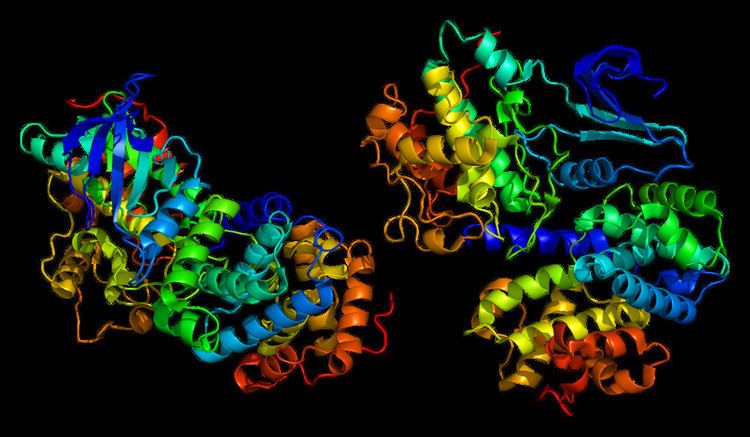Entrez 890 | Ensembl ENSG00000145386 | |
 | ||
External IDs MGI: 108069 HomoloGene: 55562 GeneCards: CCNA2 | ||
Cyclin-A2 is a protein that in humans is encoded by the CCNA2 gene. It is one of the two types of cyclin A: cyclin A1 is expressed during meiosis and embryogenesis while cyclin A2 is expressed in dividing somatic cells.
Contents
Function
Cyclin A2 belongs to the cyclin family, whose members regulate cell cycle progression by interacting with CDK kinases. Cyclin A2 is unique in that it can activate two different CDK kinases; it binds CDK2 during S phase, and CDK1 during the transition from G2 to M phase.
Cyclin A2 is synthesized at the onset of S phase and localizes to the nucleus, where the cyclin A2-CDK2 complex is implicated in the initiation and progression of DNA synthesis. Phosphorylation of CDC6 and MCM4 by the cyclin A2-CDK2 complex prevents re-replication of DNA during the cell cycle.
Cyclin A2 is involved in the G2/M transition but it cannot independently form a maturation promoting factor (MPF). Recent studies have shown that the cyclin A2-CDK1 complex triggers cyclin B1-CDK1 activation which results in chromatin condensation and the breakdown of the nuclear envelope.
Regulation
The levels of cyclin A2 are tightly synchronized with the progression of the cell cycle. Transcription initiates in late G1, peaks and plateaus in mid-S, and declines in G2.
Cyclin A2 transcription is mostly regulated by the transcription factor E2F and begins in G1, after the R point. Absence of cyclin A2 before the R point is due to the E2F inhibition by hypophosphorylated retinoblastoma protein (pRb). After the R point, pRb is phosphorylated and can no longer bind E2F, leading to cyclin A2 transcription. The cyclin A2-CDK2 complex eventually phosphorylates E2F, turning off cyclin A2 transcription. E2F promotes cyclin A2 transcription by de-repressing the promoter.
Interactions
Cyclin A2 has been shown to interact with:
Clinical significance
Cyclin A2 (Ccna2) is a key protein involved in the direction of mammalian cardiac myocytes to grow and divide, and has been shown to induce cardiac repair following myocardial infarction. Normally, Ccna2 is silenced postnatally in mammalian cardiac myocytes. Because of this gene silencing, adult heart muscle cells cannot divide readily to repair and regenerate after a heart attack.
Ccna2 has been found to induce cardiac repair in small-animal models following myocardial infarction. Preclinical trials involving injections of adenovirus which contained the Ccna2 gene into infarcted porcine (pig) hearts has shown to be protective of MI in pig hearts. Ccna2 mediated cardiac repair showed both a decrease in fibrosis in the peri-infarct tissue and a greater number of cardiomyocytes at the sites of injection. Delivery of Ccna2 into cardiac tissue invokes a regenerative response and markedly enhances cardiac function.
Cancer
Increased expression of cyclin A2 has been observed in many types of cancer such as breast, cervical, liver, and lung among others. While it is not clear whether increased expression of cyclin A2 is a cause or result of tumorigenesis, it is indicative of prognostic values such as predictions of survival or relapse.
Overexpression of cyclin A2 in mammalian cells can result in the delayed onset of metaphase and anaphase. It is also possible that cyclin A2-CDK contributes to tumorigenesis by the phosphorylation of oncoproteins or tumor suppressors like p53.
